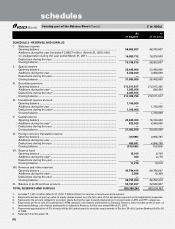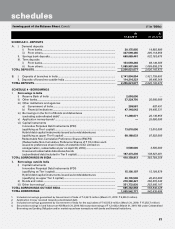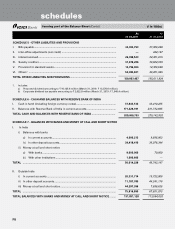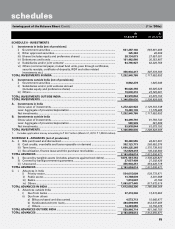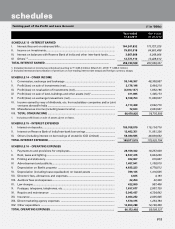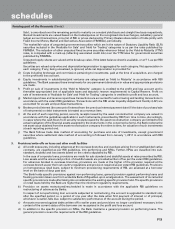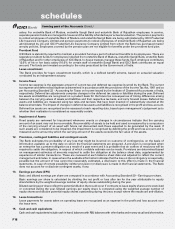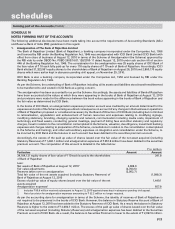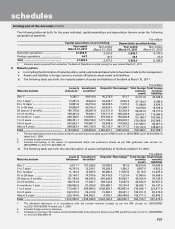ICICI Bank 2011 Annual Report Download - page 94
Download and view the complete annual report
Please find page 94 of the 2011 ICICI Bank annual report below. You can navigate through the pages in the report by either clicking on the pages listed below, or by using the keyword search tool below to find specific information within the annual report.
F16
salary. For erstwhile Bank of Madura, erstwhile Sangli Bank and erstwhile Bank of Rajasthan employees in service,
separate pension funds are managed in-house and the liability is funded as per actuarial valuation. The pension payments
to retired employees of erstwhile Bank of Madura and erstwhile Sangli Bank are being administered by ICICI Prudential
Life Insurance Company Limited and pension payments to retired employees of erstwhile Bank of Rajasthan are being
administered by LIC and ICICI Prudential Life Insurance Company Limited from whom the Bank has purchased master
annuity policies. Employees covered by the pension plan are not eligible for benefits under the provident fund plan.
Provident Fund
ICICI Bank is statutorily required to maintain a provident fund as a part of retirement benefits to its employees. There are
separate provident funds for employees inducted from erstwhile Bank of Madura, erstwhile Sangli Bank, erstwhile Bank
of Rajasthan and for other employees of ICICI Bank. In-house trustees manage these funds. Each employee contributes
12.0% of his or her basic salary (10.0% for certain staff of erstwhile Sangli Bank) and ICICI Bank contributes an equal
amount. The funds are invested according to the rules prescribed by the Government of India.
Leave encashment
The Bank provides for leave encashment benefit, which is a defined benefit scheme, based on actuarial valuation
conducted by an independent actuary.
10. Income Taxes
Income tax expense is the aggregate amount of current tax and deferred tax expense incurred by the Bank. The current
tax expense and deferred tax expense is determined in accordance with the provisions of the Income Tax Act, 1961 and as
per Accounting Standard 22 - Accounting for Taxes on Income issued by the Institute of Chartered Accountants of India,
respectively. Deferred tax adjustments comprise changes in the deferred tax assets or liabilities during the year. Deferred
tax assets and liabilities are recognised on a prudent basis for the future tax consequences of timing differences arising
between the carrying values of assets and liabilities and their respective tax basis, and carry forward losses. Deferred tax
assets and liabilities are measured using tax rates and tax laws that have been enacted or substantively enacted at the
balance sheet date. The impact of changes in deferred tax assets and liabilities is recognised in the profit and loss account.
Deferred tax assets are recognised and re-assessed at each reporting date, based upon management’s judgement as to
whether their realisation is considered as reasonably certain.
11. Impairment of Assets
Fixed assets are reviewed for impairment whenever events or changes in circumstances indicate that the carrying
amount of an asset may not be recoverable. Recoverability of assets to be held and used is measured by a comparison
of the carrying amount of an asset with future net discounted cash flows expected to be generated by the asset. If
such assets are considered to be impaired, the impairment is recognised by debiting the profit and loss account and is
measured as the amount by which the carrying amount of the assets exceeds the fair value of the assets.
12. Provisions, contingent liabilities and contingent assets
The Bank estimates the probability of any loss that might be incurred on outcome of contingencies on the basis of
information available up to the date on which the financial statements are prepared. A provision is recognised when
an enterprise has a present obligation as a result of a past event and it is probable that an outflow of resources will be
required to settle the obligation, in respect of which a reliable estimate can be made. Provisions are determined based
on management estimates of amounts required to settle the obligation at the balance sheet date, supplemented by
experience of similar transactions. These are reviewed at each balance sheet date and adjusted to reflect the current
management estimates. In cases where the available information indicates that the loss on the contingency is reasonably
possible but the amount of loss cannot be reasonably estimated, a disclosure to this effect is made in the financial
statements. In case of remote possibility neither provision nor disclosure is made in the financial statements. The Bank
does not account for or disclose contingent assets, if any.
13. Earnings per share (EPS)
Basic and diluted earnings per share are computed in accordance with Accounting Standard-20 – Earnings per share.
Basic earnings per share is calculated by dividing the net profit or loss after tax for the year attributable to equity
shareholders by the weighted average number of equity shares outstanding during the year.
Diluted earnings per share reflect the potential dilution that could occur if contracts to issue equity shares were exercised
or converted during the year. Diluted earnings per equity share is computed using the weighted average number of
equity shares and dilutive potential equity shares outstanding during the year, except where the results are anti-dilutive.
14. Lease transactions
Lease payments for assets taken on operating lease are recognised as an expense in the profit and loss account over
the lease term.
15. Cash and cash equivalents
Cash and cash equivalents include cash in hand, balances with RBI, balances with other banks and money at call and short notice.
forming part of the Accounts (Contd.)
schedules


